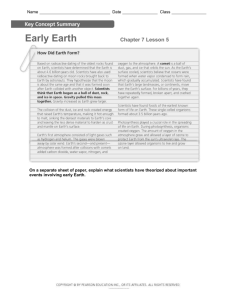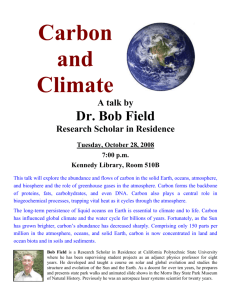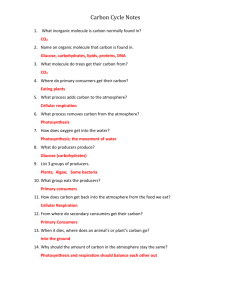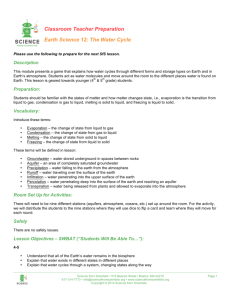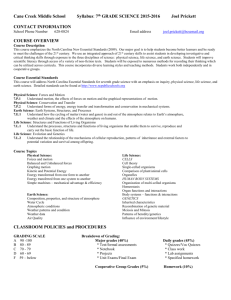Name - SkyView Academy
advertisement
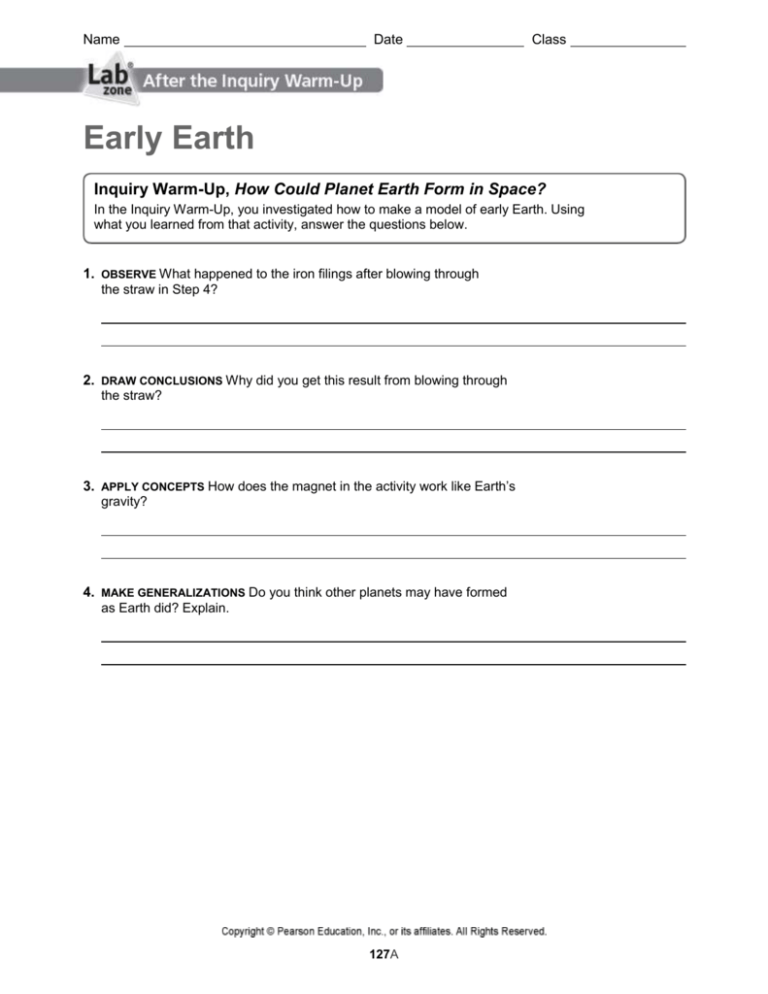
Name Date Class Early Earth Inquiry Warm-Up, How Could Planet Earth Form in Space? In the Inquiry Warm-Up, you investigated how to make a model of early Earth. Using what you learned from that activity, answer the questions below. 1. OBSERVE What happened to the iron filings after blowing through the straw in Step 4? 2. DRAW CONCLUSIONS Why did you get this result from blowing through the straw? 3. APPLY CONCEPTS How does the magnet in the activity work like Earth’s gravity? 4. MAKE GENERALIZATIONS Do you think other planets may have formed as Earth did? Explain. 127A Name Date Class Early Earth How Did Earth Form? 1a. IDENTIFY Earth formed years ago. b. SEQUENCE Write the numbers 1, 2, and 3 to show the correct order of the events below. Ozone layer forms. Earth loses its first atmosphere. Volcanoes and collisions with comets add water vapor to the atmosphere. c. CHALLENGE How would Earth’s atmosphere be different if organisms capable of photosynthesis had not evolved. I get it! Now I know that key features of early Earth were I need extra help with 127B Name Date Class Early Earth On a separate sheet of paper, explain what scientists have theorized about important events involving early Earth. 127C Name Date Class Early Earth Understanding Main Ideas Put the six events or processes in the correct sequence by writing their letters in the correct order in the numbered blanks below. A. Volcanic eruptions release carbon dioxide into the atmosphere. B. Early organisms release oxygen into the air. C. Oceans form on Earth’s surface. D. Hydrogen and helium are captured by gravity to form an atmosphere. E. A dense, iron core forms at Earth’s center. F. Earth is a ball of dust, rock, and ice in space. 1. 2. 3. 4. 5. 6. Answer the following questions on a separate sheet of paper. 7. What were the earliest life forms on Earth like? 8. What hypothesis explains why Earth and the moon are about the same age? 9. How did photosynthesis lead to the development of animals living on land? 10. How have scientists used radioactive dating to show that Earth is about 4.6 billion years old? Building Vocabulary Fill in the blank to complete each statement. 11. A(n) 12. The process of from the sun to make food. is a ball of dust and ice that orbits the sun. involves organisms using energy 127D Name Date Class Early Earth Read the passage below and then answer the questions that follow in the spaces provided. Life and Earth’s Atmosphere More than 3 billion years ago, an amazing thing happened on Earth. Certain types of bacteria developed the ability to make their own food. These bacteria made food by using a process called photosynthesis. Using energy from the sun, the bacteria combined carbon dioxide and water to make food and oxygen. The oxygen that was given off had a big effect on Earth’s atmosphere. At first, the oxygen was taken up by iron that was in the ocean water. This caused the iron and oxygen, or iron oxides, to fall to the ocean bottom and form deposits of iron-rich sedimentary rock. Most of the iron that is used today to make cars and buildings comes from these deposits. Eventually most of the iron in the oceans had combined with oxygen and fallen to the ocean floor. Now, oxygen that was produced by microbes was free to enter the atmosphere. As a result, the oxygen level in Earth’s atmosphere began to increase significantly about 2.5 billion years ago. Slowly, over hundreds of millions of years, the oxygen level increased to the present-day level of about 20 percent. The buildup of oxygen in Earth’s atmosphere allowed the emergence of organisms that cannot exist without oxygen. Animals, for example, take in oxygen, combine it with the food they eat, and produce a waste product; carbon dioxide. 1. What advantage does an organism have because of photosynthesis? 2. What gas is given off during photosynthesis? 3. After certain types of bacteria first started producing oxygen, where did most of the oxygen go? 4. Why was the buildup of oxygen in Earth’s atmosphere important for animals and other types of organisms? 127E Name Date Class Early Earth Write the letter of the correct answer on the line at the left. 1. According to scientists, both Earth and the moon are A about 1.6 billion years old B about 4.6 billion years old C about 9.6 billion years old D about 14 billion years old 2. After water vapor condensed to form rain and then gradually accumulated, which of the following was formed? A Earth’s first atmosphere B Earth’s second atmosphere C Earth’s oceans D Earth’s continents 3. Which of the following is not an important part of Earth’s second atmosphere? A helium B oxygen C water vapor D carbon dioxide 4. The earliest form of life known on Earth were A leafy plants B bacteria C fossils D single-celled organisms Fill in the blank to complete each statement. 5. Scientists believe that and the moon are about the same age. 6. According to scientists, Earth began as a ball of dust, rock, and in space. 7. 8. A(n) pulled this mass together. is a ball of dust, gas, and ice that orbits the sun. 9. According to scientists, over billions of years, Earth’s formed, broken apart, and crashed together again. have 10. Scientists believe that Earth’s core and crust formed after the materials pulled by Earth’s gravity became very hot and . 127F Early Earth Answer Key 8. When Earth was very young, it collided with a large object. The collision threw a large amount of material from both bodies into orbit around Earth. This material combined to form the moon. 1. Answers should indicate that the iron filings gathered on the surface of the paper around the poles of the magnet. 9. In photosynthesis, oxygen is released as a 2. Answers will vary. Sample: The force of the waste product. Oxygen released into the air was changed into ozone, which blocks out ultraviolet rays of the sun. magnet was strong enough to attract the filings from that distance across the paper. 3. Answers will vary. Students may indicate that 10. Scientists used radioactive dating to show that like the gravity, which pulled materials in space into a ball, the magnet pulled the iron filings into a clump. the oldest moon rocks are about 4.6 billion years old. Because Earth is slightly older than the moon, Earth must be roughly 4.6 billion years old. 4. Answers will vary. Students may indicate that other planets formed the same way as Earth. Gravity pulled particles in space into a sphere. 11. comet 12. photosynthesis Scientists have theorized that Earth began as a ball of dust, rock, and ice in space; that gravity gathered these materials, which melted and formed Earth’s core, crust, and mantle; that many of the elements of Earth’s atmosphere were added after it collided with comets; that oceans and continents later formed; and that 2.5 billion years ago, photosynthesis finally allowed many organism to grow. 1. It can make its own food. 2. oxygen 3. Most oxygen was taken up by iron in the oceans and settled to the ocean floor along with the iron. 4. Animals and other types of organisms use oxygen to get energy from food. 1. F 2. E 1. B 2. C 3. D 3. A 4. D 4. A 5. Earth 6. ice 5. C 7. Gravity 8. comet 6. B 9. landmasses 7. They were single-celled organisms that were probably similar to present-day bacteria. 127G 10. melted 127H
